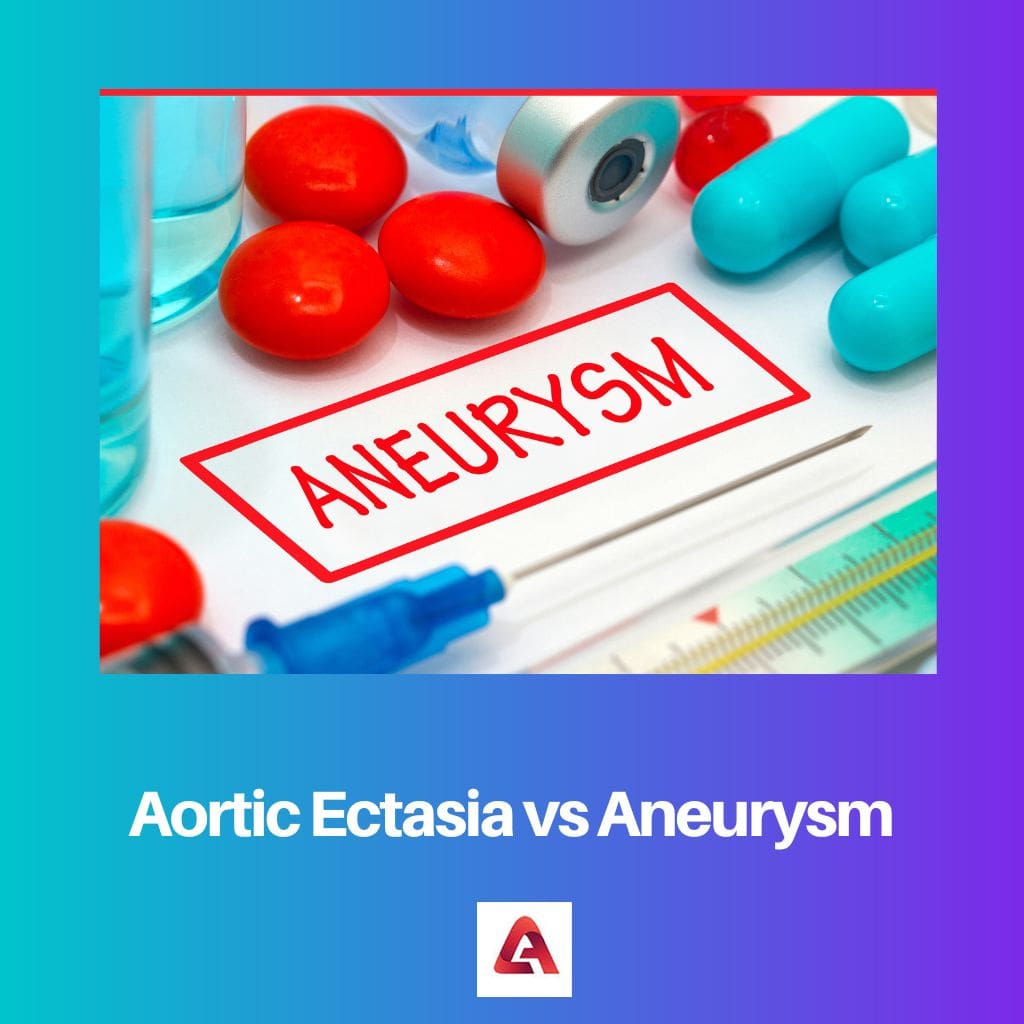An aortic ectasia tends to be a situation when a section of the aorta increases in width. This is by less than 50% of its normal width. An aneurysm occurs when a blood vessel widens to about 50% plus more of the vessel’s original diameter.
Key Takeaways
- Aortic ectasia is the dilation of the aorta, while an aneurysm is a localized bulging or ballooning of the blood vessel wall.
- Aortic ectasia is less severe than an aneurysm and has a lower risk of rupture.
- Treatment for aortic ectasia may involve medication and monitoring, while aneurysms require surgical intervention.

Aortic Ectasia vs Aneurysm
Dilation of any tubular structure, specifically the dilatation of the coronary artery due to high blood pressure, is known as Ectasia. Aneurysm is the swelling at any spot of blood vessels is mainly due to the weakening of blood vessels. It also shows the bulging of vessels.
Comparison Table
| Parameters of Comparison | Aortic Ectasia | Aneurysm |
|---|---|---|
| Causes | Atherosclerosis is a main cause and even a complication of the disorder primary aldosteronism | Hypertension and atherosclerosis are main causes and also other disorders like Marfan’s syndrome |
| Symptoms | Usually no symptoms are present of the condition | Only when an aneurysm dissects or ruptures will symptoms be present |
| Diagnosis | A diagnosis occurs by an ultrasound to figure out if one has this condition | Imaging tests like angiograms, CT scans, MRI, and ultrasound may let one know that an aneurysm is there |
| Treatment | Medication that can decrease blood pressure may stop the vessel wall from widening more | Treatment will depend on where the aneurysm is located |
| Diameter of dilation within the aorta | This is diagnosed if the width of the dilated region will be 2.6 to 2.9 cm wide | This is diagnosed if the width of the dilated region will be 3cm and more |
What is Aorta Ectasia?
An aortic ectasia will be a widening of one’s aorta. This will be less than 50% of the normal vessel. The width of the dilated area will be 2.6 to 2.9 cm wide.
The width of the bulge will even be less than the length. The aortic ectasia is viewed as a diffuse swollen area.
Medicine that can lower blood pressure will be used to help treat the condition. A small ectasia can be treated medically; doctors wait to see what happens. When the area keeps on expanding to develop into an aneurysm, surgery will then occur.
This is why an aortic ectasia is a swollen section of one’s aorta that will not be big and is longer than wide.
An ectasia can develop into an aneurysm. Both are, however not the same as aortic ectasia will not be as wide of an area.
But, if the vessel widens more, this can become an aneurysm. Ectasia is not serious. This is unless the width keeps on expanding.
Aortic ectasia is not very common among young, healthy individuals, but it can become more likely as one age.
What is Aneurysm?
An aneurysm is said to be a widened section of the blood vessel that bulges outwards. This will be above 50% of the diameter of the particular normal vessel. It is even in a focused area.
If the width of the dilated area gets to 3 cm and above, an aneurysm is diagnosed. The width will be bigger in comparison to the length.
An aneurysm will be a focal swollen area. The treatment of an aneurysm varies. This depends upon where it is present in the body. If it is in the brain, surgical clipping off of it can occur.
If it is in the aorta, a surgical replacement of the damaged area will happen. Surgical intervention to help replace the harmed section with a graft aids in stopping life-threatening dissection plus rupture of the vessel.
Therefore an aneurysm will be a focused area of the blood vessel that will bulge out and requires surgical repair. When one needs to find out if they have an aneurysm, imaging tests can occur for this, which will show if it is present.
One must get treatment when they find out that they have an aneurysm because it may be dangerous.

Main Differences Between Aortic Ectasia and Aneurysm
- An aortic ectasia will lead to a widening of the aorta that will be less than 50% of the expected diameter, whilst, in an aneurysm, the widening will be more than 50% of the expected diameter.
- The diameter of dilation in the aorta for an aortic ectasia will be 2.6 to 2.9 cm and 3 cm or more for the aneurysm.
- The width will be smaller than the length of an aortic ectasia, and the width will be bigger in length for the aneurysm.
- For aortic ectasia, one needs to take medication to limit blood pressure while surgical clipping of the aneurysm will occur if it is in the brain or surgical replacement will need to occur of the damaged section when it is in the aorta to treat an aneurysm. Therefore, an aneurysm is more serious and must be treated properly and carefully.
- An aortic ectasia tends to be longer than wider. It is also narrower in diameter in comparison to an aneurysm. An aneurysm will be more of a localized type of bulge. It will be wider than it is long. The ectasia will become serious if its width of it keeps on expanding.



